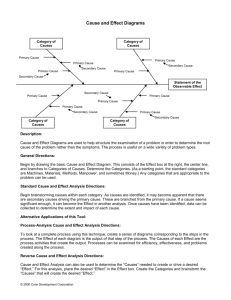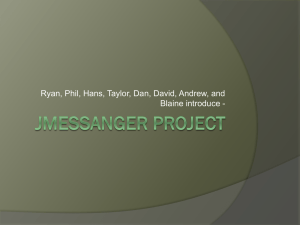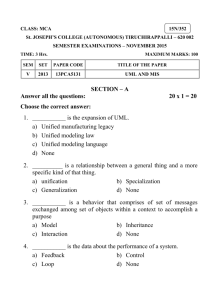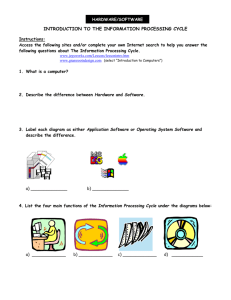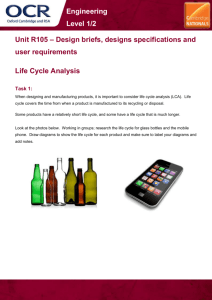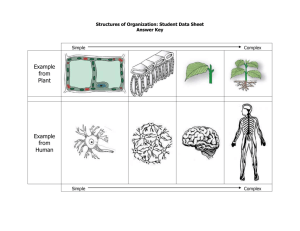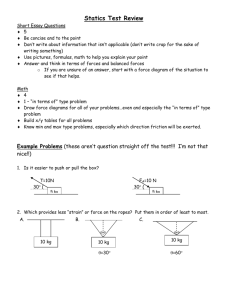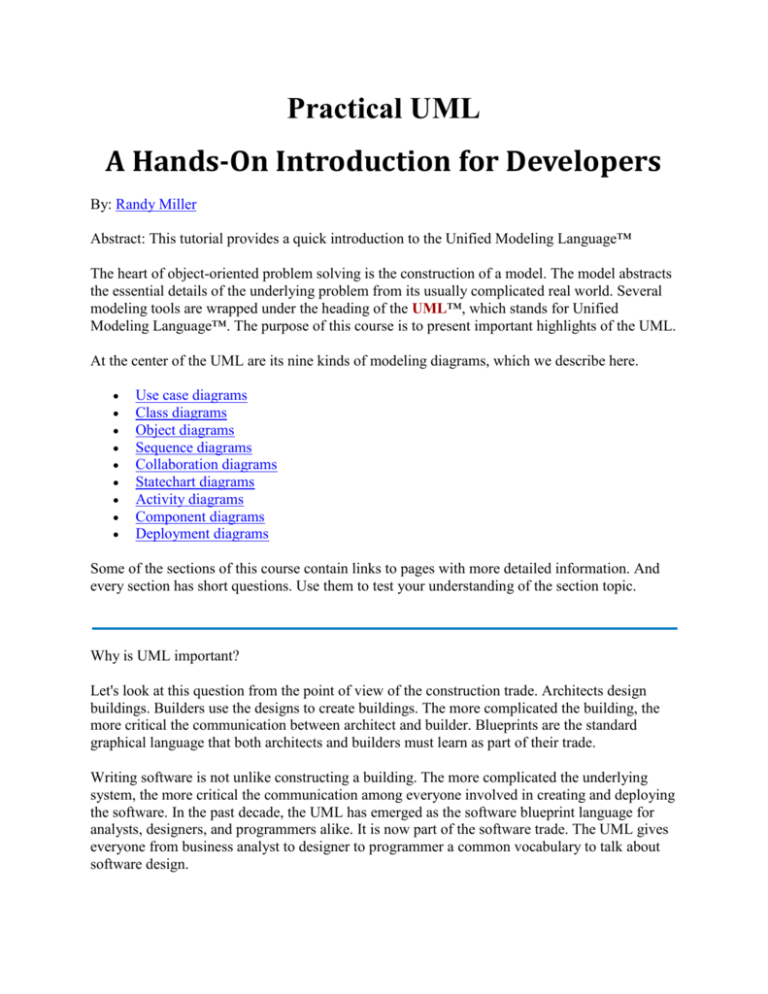
Practical UML
A Hands-On Introduction for Developers
By: Randy Miller
Abstract: This tutorial provides a quick introduction to the Unified Modeling Language™
The heart of object-oriented problem solving is the construction of a model. The model abstracts
the essential details of the underlying problem from its usually complicated real world. Several
modeling tools are wrapped under the heading of the UML™, which stands for Unified
Modeling Language™. The purpose of this course is to present important highlights of the UML.
At the center of the UML are its nine kinds of modeling diagrams, which we describe here.
Use case diagrams
Class diagrams
Object diagrams
Sequence diagrams
Collaboration diagrams
Statechart diagrams
Activity diagrams
Component diagrams
Deployment diagrams
Some of the sections of this course contain links to pages with more detailed information. And
every section has short questions. Use them to test your understanding of the section topic.
Why is UML important?
Let's look at this question from the point of view of the construction trade. Architects design
buildings. Builders use the designs to create buildings. The more complicated the building, the
more critical the communication between architect and builder. Blueprints are the standard
graphical language that both architects and builders must learn as part of their trade.
Writing software is not unlike constructing a building. The more complicated the underlying
system, the more critical the communication among everyone involved in creating and deploying
the software. In the past decade, the UML has emerged as the software blueprint language for
analysts, designers, and programmers alike. It is now part of the software trade. The UML gives
everyone from business analyst to designer to programmer a common vocabulary to talk about
software design.
The UML is applicable to object-oriented problem solving. Anyone interested in learning UML
must be familiar with the underlying tenet of object-oriented problem solving -- it all begins with
the construction of a model. A model is an abstraction of the underlying problem. The domain is
the actual world from which the problem comes.
Models consist of objects that interact by sending each other messages. Think of an object as
"alive." Objects have things they know (attributes) and things they can do (behaviors or
operations). The values of an object's attributes determine its state.
Classes are the "blueprints" for objects. A class wraps attributes (data) and behaviors (methods
or functions) into a single distinct entity. Objects are instances of classes.
Use case diagrams
Use case diagrams describe what a system does from the standpoint of an external observer.
The emphasis is on what a system does rather than how.
Use case diagrams are closely connected to scenarios. A scenario is an example of what happens
when someone interacts with the system. Here is a scenario for a medical clinic.
"A patient calls the clinic to make an appointment for a yearly checkup. The receptionist
finds the nearest empty time slot in the appointment book and schedules the appointment
for that time slot. "
A use case is a summary of scenarios for a single task or goal. An actor is who or what initiates
the events involved in that task. Actors are simply roles that people or objects play. The picture
below is a Make Appointment use case for the medical clinic. The actor is a Patient. The
connection between actor and use case is a communication association (or communication for
short).
Hide image
Actors are stick figures. Use cases are ovals. Communications are lines that link actors to use
cases.
A use case diagram is a collection of actors, use cases, and their communications. We've put
Make Appointment as part of a diagram with four actors and four use cases. Notice that a single
use case can have multiple actors.
Hide image
Use case diagrams are helpful in three areas.
determining features (requirements). New use cases often generate new requirements
as the system is analyzed and the design takes shape.
communicating with clients. Their notational simplicity makes use case diagrams a
good way for developers to communicate with clients.
generating test cases. The collection of scenarios for a use case may suggest a suite of
test cases for those scenarios.
Class diagrams
A Class diagram gives an overview of a system by showing its classes and the relationships
among them. Class diagrams are static -- they display what interacts but not what happens when
they do interact.
The class diagram below models a customer order from a retail catalog. The central class is the
Order. Associated with it are the Customer making the purchase and the Payment. A Payment
is one of three kinds: Cash, Check, or Credit. The order contains OrderDetails (line items),
each with its associated Item.
Hide image
UML class notation is a rectangle divided into three parts: class name, attributes, and operations.
Names of abstract classes, such as Payment, are in italics. Relationships between classes are the
connecting links.
Our class diagram has three kinds of relationships.
association -- a relationship between instances of the two classes. There is an association
between two classes if an instance of one class must know about the other in order to
perform its work. In a diagram, an association is a link connecting two classes.
aggregation -- an association in which one class belongs to a collection. An aggregation
has a diamond end pointing to the part containing the whole. In our diagram, Order has a
collection of OrderDetails.
generalization -- an inheritance link indicating one class is a superclass of the other. A
generalization has a triangle pointing to the superclass. Payment is a superclass of Cash,
Check, and Credit.
An association has two ends. An end may have a role name to clarify the nature of the
association. For example, an OrderDetail is a line item of each Order.
A navigability arrow on an association shows which direction the association can be traversed
or queried. An OrderDetail can be queried about its Item, but not the other way around. The
arrow also lets you know who "owns" the association's implementation; in this case,
OrderDetail has an Item. Associations with no navigability arrows are bi-directional.
The multiplicity of an association end is the number of possible instances of the class associated
with a single instance of the other end. Multiplicities are single numbers or ranges of numbers. In
our example, there can be only one Customer for each Order, but a Customer can have any
number of Orders.
This table gives the most common multiplicities.
Multiplicities
Meaning
zero or one instance. The notation n . . m indicates n to m instances.
0..1
0..* or *
no limit on the number of instances (including none).
exactly one instance
1
at least one instance
1..*
Every class diagram has classes, associations, and multiplicities. Navigability and roles are
optional items placed in a diagram to provide clarity.
Packages and object diagrams
To simplify complex class diagrams, you can group classes into packages. A package is a
collection of logically related UML elements. The diagram below is a business model in which
the classes are grouped into packages.
Hide image
Packages appear as rectangles with small tabs at the top. The package name is on the tab or
inside the rectangle. The dotted arrows are dependencies. One package depends on another if
changes in the other could possibly force changes in the first.
Object diagrams show instances instead of classes. They are useful for explaining small pieces
with complicated relationships, especially recursive relationships.
This small class diagram shows that a university Department can contain lots of other
Departments.
Hide image
The object diagram below instantiates the class diagram, replacing it by a concrete example.
Hide image
Each rectangle in the object diagram corresponds to a single instance. Instance names are
underlined in UML diagrams. Class or instance names may be omitted from object diagrams as
long as the diagram meaning is still clear.
Sequence diagrams
Class and object diagrams are static model views. Interaction diagrams are dynamic. They
describe how objects collaborate.
A sequence diagram is an interaction diagram that details how operations are carried out -- what
messages are sent and when. Sequence diagrams are organized according to time. The time
progresses as you go down the page. The objects involved in the operation are listed from left to
right according to when they take part in the message sequence.
Below is a sequence diagram for making a hotel reservation. The object initiating the sequence
of messages is a Reservation window.
Hide image
The Reservation window sends a makeReservation() message to a HotelChain. The
HotelChain then sends a makeReservation() message to a Hotel. If the Hotel has available
rooms, then it makes a Reservation and a Confirmation.
Each vertical dotted line is a lifeline, representing the time that an object exists. Each arrow is a
message call. An arrow goes from the sender to the top of the activation bar of the message on
the receiver's lifeline. The activation bar represents the duration of execution of the message.
In our diagram, the Hotel issues a self call to determine if a room is available. If so, then the
Hotel creates a Reservation and a Confirmation. The asterisk on the self call means iteration
(to make sure there is available room for each day of the stay in the hotel). The expression in
square brackets, [ ], is a condition.
The diagram has a clarifying note, which is text inside a dog-eared rectangle. Notes can be put
into any kind of UML diagram.
Collaboration diagrams
Collaboration diagrams are also interaction diagrams. They convey the same information as
sequence diagrams, but they focus on object roles instead of the times that messages are sent. In
a sequence diagram, object roles are the vertices and messages are the connecting links.
Hide image
The object-role rectangles are labeled with either class or object names (or both). Class names
are preceded by colons ( : ).
Each message in a collaboration diagram has a sequence number. The top-level message is
numbered 1. Messages at the same level (sent during the same call) have the same decimal prefix
but suffixes of 1, 2, etc. according to when they occur.
Statechart diagrams
Objects have behaviors and state. The state of an object depends on its current activity or
condition. A statechart diagram shows the possible states of the object and the transitions that
cause a change in state.
Our example diagram models the login part of an online banking system. Logging in consists of
entering a valid social security number and personal id number, then submitting the information
for validation.
Logging in can be factored into four non-overlapping states: Getting SSN, Getting PIN,
Validating, and Rejecting. From each state comes a complete set of transitions that determine
the subsequent state.
Hide image
States are rounded rectangles. Transitions are arrows from one state to another. Events or
conditions that trigger transitions are written beside the arrows. Our diagram has two selftransition, one on Getting SSN and another on Getting PIN.
The initial state (black circle) is a dummy to start the action. Final states are also dummy states
that terminate the action.
The action that occurs as a result of an event or condition is expressed in the form /action.
While in its Validating state, the object does not wait for an outside event to trigger a transition.
Instead, it performs an activity. The result of that activity determines its subsequent state.
Activity diagrams
An activity diagram is essentially a fancy flowchart. Activity diagrams and statechart diagrams
are related. While a statechart diagram focuses attention on an object undergoing a process (or
on a process as an object), an activity diagram focuses on the flow of activities involved in a
single process. The activity diagram shows the how those activities depend on one another.
For our example, we used the following process.
"Withdraw money from a bank account through an ATM."
The three involved classes (people, etc.) of the activity are Customer, ATM, and Bank. The
process begins at the black start circle at the top and ends at the concentric white/black stop
circles at the bottom. The activities are rounded rectangles.
Hide image
Activity diagrams can be divided into object swimlanes that determine which object is
responsible for which activity. A single transition comes out of each activity, connecting it to
the next activity.
A transition may branch into two or more mutually exclusive transitions. Guard expressions
(inside [ ]) label the transitions coming out of a branch. A branch and its subsequent merge
marking the end of the branch appear in the diagram as hollow diamonds.
A transition may fork into two or more parallel activities. The fork and the subsequent join of
the threads coming out of the fork appear in the diagram as solid bars.
Component and deployment diagrams
A component is a code module. Component diagrams are physical analogs of class diagram.
Deployment diagrams show the physical configurations of software and hardware.
The following deployment diagram shows the relationships among software and hardware
components involved in real estate transactions.
Hide image
The physical hardware is made up of nodes. Each component belongs on a node. Components
are shown as rectangles with two tabs at the upper left.
UML Tools and Modeling Tools
Creating and modifying UML diagrams can be labor and time intensive. The UML modeling
tools from Embarcadero Technologies make it easy to create diagrams like the ones in this article
plus they provide a great amount of other functionality including model and code
synchronization.
Embarcadero Delphi is the fastest way to build native Windows applications. The Professional
edition includes UML code visualization. The Enterprise edition includes modeling with two
way synchronization between model and code. The Architect edition includes the ability to
create language-neutral UML modeling projects. Learn more about Delphi or download a trial
edition of Delphi and try it for yourself.
Similar UML modeling functionality is available for C++ in C++Builder, for Java in JBuilder
and for Windows in Embarcadero RAD Studio. Database modeling and business modeling
are available in Embarcadero ER/Studio and ER/Studio Business Architect.
For the latest up-to-date techniques in the Unified Modeling Language and Agile Software
Development Processes, and for all of the latest information on how to deliver better software
faster, visit The Embarcadero Developer Network
Copyright © 2003 Borland Software Corporation, Inc. All rights reserved. All Borland and
Borland brands and product names are trademarks or registered trademarks of Borland. You may
not use any of the Borland trademarks without Borland's prior written permission. All other
brand and product names may be trademarks or registered trademarks of their respective holders.

